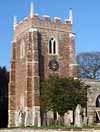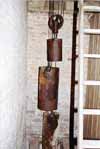Hawksworth St Mary and All SaintsClock
 The clock face The clock face
after restoration
in April 2012 |
The church has two clock faces on the brick built tower, one facing north and one south, each sited just below the bell chamber openings. Each clock face is painted black with gold numerals and is run by a motorised unit linked to an electronic control unit. This control unit replaced the original clockwork mechanism in 2000 and gives complete flexibility of when the clock strikes; currently it chimes on the quarter hour using the church bells and hammers. Night time silencing is in place and the clock has automatic summer/winter changes. It is split-second accurate by being radio-controlled from Rugby, the British radio controlling clock. The clock faces and the original turret clockwork mechanism were presented to Hawksworth church in 1873 by the Rev John Blurton Webb, who was rector of Hawksworth between 1873 and 1878. The chime was formed by hammers striking the church bells and a third bell was added by the Rev JB Webb, also in 1873, to strike the hour. The original mechanical movement gave one chime at a quarter past the hour, two at half past, three at quarter to and four chimes on the hour before then striking the number for the hour. It ran for 24 hours a day since there was only a simple on/off option.
 The clock mechanism in The clock mechanism in
its original position in
the tower (now removed) |
 The clock weights The clock weights |
The double-framed turret clock mechanism is about four feet wide and was made of cast iron by Reuben Bosworth of Nottingham. No information is available on the date of the clock or of how much the Rev JB Webb paid for it but a similar Bosworth turret clock was installed in Arnold St Mary chapel around the same time in 1868 at a cost of £161 12s 2d. The clockwork mechanism is no longer in use and has been removed from the tower, but originally it was housed in a chamber inside the tower reached by ladders. It was run by heavy weights and needed winding up by hand at least every six days. A rota of village men kept it going from 1873 until the mid 1990s and over the years, many people, including a prisoner of war during World War Two added their autographs to the walls in the winding chamber as they climbed up to wind the clock. The original weights still hang in the cupboard built just inside and to the left of the west entrance door.
Restoration of the clock was successful in keeping it running for many years. A receipt from 29 April 1950 shows that total repairs to the clock cost £14-0s-0d which included £3-10s-0d to G & F Cope & Co, Clock Manufacturers of Lenton, Nottingham, for supplying and fitting a new steel line. In June 1977 the clock mechanism was restored by a resident of Hawksworth, who also repainted the clock faces. The clockwork mechanism finally failed during the 1990s and the decision was taken to replace the old clockwork unit with a motorised unit with an electronic control unit and electric bell strikers. Thanks to a private donation, this unit was installed at a cost of £3,350 in 2000 and the clock once again began to chime on the quarter hour.
In 2012 when scaffolding was erected up the tower for a significant programme of church tower restoration, the clock faces were removed to the clock repairer’s workshop for special priming and gold leafing and the hands were stripped and blacked. Each clock face was fitted with an individual new electric motor set behind the face. This meant the two clock faces no longer needed to be linked to each other by the bevel gears and rods of the original installation and they were re-positioned to just below the bell chamber openings. Previously, when installed in 1873, they had been sited in a position which partially obscured the bell chamber opening and caused damage to some of the stone courses. The total cost of this recent restoration was £3,462 which was donated by WB Stubbs Limited of Hawksworth.
|